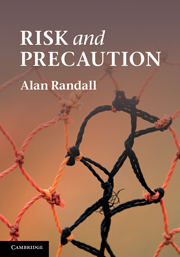Book contents
- Frontmatter
- Contents
- List of figures
- List of boxes
- Authors cited
- Acknowledgements
- List of acronyms
- Part I The precautionary principle – why so much fuss about such a simple idea?
- Part II Harm and chance – managing risk
- Part III Defining and justifying a coherent precautionary principle
- Part IV Precaution in action
- Part V Conclusion
- 14 A role for precaution in an integrated risk management framework
- References
- Index
14 - A role for precaution in an integrated risk management framework
Published online by Cambridge University Press: 05 June 2012
- Frontmatter
- Contents
- List of figures
- List of boxes
- Authors cited
- Acknowledgements
- List of acronyms
- Part I The precautionary principle – why so much fuss about such a simple idea?
- Part II Harm and chance – managing risk
- Part III Defining and justifying a coherent precautionary principle
- Part IV Precaution in action
- Part V Conclusion
- 14 A role for precaution in an integrated risk management framework
- References
- Index
Summary
Imagine a threat of substantial but uncertain harm. What should we do? If we wait until we are sure about the threat, the best opportunities for effective remedies already may be lost. If we act precipitously to forestall the uncertain harm, we run the risk of wasting resources and foreclosing opportunities for gain, all in pursuit of protection from illusory harm. Recent history provides plenty of examples of the costs of waiting too long to act (e.g. asbestos, Boxes 1.1 and 5.4; PCBs, Box 9.2; and MTBE, Box 9.3) and we risk a similar outcome regarding climate change. The costs and lost opportunities resulting from precipitous action to forestall illusory harm are more speculative but thoroughly plausible. Obviously, both strategies – waiting until we are really sure, and acting before we are sure – have their potential downsides. Proposals for more systematic application of the precautionary principle (PP) come from people who are persuaded more by the arguments against waiting too long. They tend to present the PP as a commonsense defense against unreasonable risks.
Various governments have adopted the precautionary approach or principle, and it has been incorporated into several international agreements (Chapter 2). Even in the USA, which has not made a general commitment to precaution, we see precautionary regulation institutionalized in particular cases (e.g. new pharmaceutical drugs and pesticides), and it can be argued that precaution is expressed via sustainability objectives in, for example, fisheries management (Chapter 13).
- Type
- Chapter
- Information
- Risk and Precaution , pp. 243 - 250Publisher: Cambridge University PressPrint publication year: 2011



